Blending/Overlaying images¶
Introduction¶
Most augmenters in the library affect images in uniform ways per image. Sometimes one might not want that and instead desires more localized effects (e.g. change the color of some image regions, while keeping the others unchanged) or wants to keep a fraction of the old image (e.g. blur the image and mix in a bit of the unblurred image). Blending augmenters are intended for these use cases. They either mix two images using a constant alpha factor or using a pixel-wise mask. Below image shows examples.
# First row
iaa.BlendAlpha(
(0.0, 1.0),
foreground=iaa.MedianBlur(11),
per_channel=True
)
# Second row
iaa.BlendAlphaSimplexNoise(
foreground=iaa.EdgeDetect(1.0),
per_channel=False
)
# Third row
iaa.BlendAlphaSimplexNoise(
foreground=iaa.EdgeDetect(1.0),
background=iaa.LinearContrast((0.5, 2.0)),
per_channel=0.5
)
# Forth row
iaa.BlendAlphaFrequencyNoise(
foreground=iaa.Affine(
rotate=(-10, 10),
translate_px={"x": (-4, 4), "y": (-4, 4)}
),
background=iaa.AddToHueAndSaturation((-40, 40)),
per_channel=0.5
)
# Fifth row
iaa.BlendAlphaSimplexNoise(
foreground=iaa.BlendAlphaSimplexNoise(
foreground=iaa.EdgeDetect(1.0),
background=iaa.LinearContrast((0.5, 2.0)),
per_channel=True
),
background=iaa.BlendAlphaFrequencyNoise(
exponent=(-2.5, -1.0),
foreground=iaa.Affine(
rotate=(-10, 10),
translate_px={"x": (-4, 4), "y": (-4, 4)}
),
background=iaa.AddToHueAndSaturation((-40, 40)),
per_channel=True
),
per_channel=True,
aggregation_method="max",
sigmoid=False
)

Various effects of combining alpha-augmenters with other augmenters.
First row shows imgaug.augmenters.blend.BlendAlpha with
imgaug.augmenters.blur.MedianBlur,
second imgaug.augmenters.blend.BlendAlphaSimplexNoise with
imgaug.augmenters.convolutional.EdgeDetect,
third imgaug.augmenters.blend.BlendAlphaSimplexNoise with
imgaug.augmenters.convolutional.EdgeDetect and
imgaug.augmenters.contrast.ContrastNormalization,
third shows
imgaug.augmenters.blend.BlendAlphaFrequencyNoise with
imgaug.augmenters.geometric.Affine and
imgaug.augmenters.color.AddToHueAndSaturation
and forth row shows a mixture
imgaug.augmenters.blend.BlendAlphaSimplexNoise and
imgaug.augmenters.blend.BlendAlphaFrequencyNoise.
Imagewise Constant Alphas Values¶
The augmenter imgaug.augmenters.blend.BlendAlpha allows to mix the
results of two augmentation branches using an alpha factor that is constant
throughout the whole image, i.e. it follows roughly
I_blend = alpha * I_fg + (1 - alpha) * I_bg per image, where I_fg is
the image from the foreground branch and I_bg is the image from the
background branch.
Often, the first branch will be an augmented version of the image and
the second branch will be the identity function, leading to a blend of
augmented and unaugmented image. The background branch can also contain
non-identity augmenters, leading to a blend of two distinct augmentation
effects.
imgaug.augmenters.blend.BlendAlpha is already built into some
augmenters as a parameter, e.g. into
imgaug.augmenters.convolutional.EdgeDetect.
The below example code generates images that are a blend between
imgaug.augmenters.convolutional.Sharpen and
imgaug.augmenters.arithmetic.CoarseDropout. Notice how the
sharpening does not affect the black rectangles from dropout, as the two
augmenters are both applied to the original
images and merely blended.
import imgaug as ia
from imgaug import augmenters as iaa
ia.seed(1)
# Example batch of images.
# The array has shape (8, 128, 128, 3) and dtype uint8.
images = np.array(
[ia.quokka(size=(128, 128)) for _ in range(8)],
dtype=np.uint8
)
seq = iaa.BlendAlpha(
factor=(0.2, 0.8),
foreground=iaa.Sharpen(1.0, lightness=2),
background=iaa.CoarseDropout(p=0.1, size_px=8)
)
images_aug = seq(images=images)
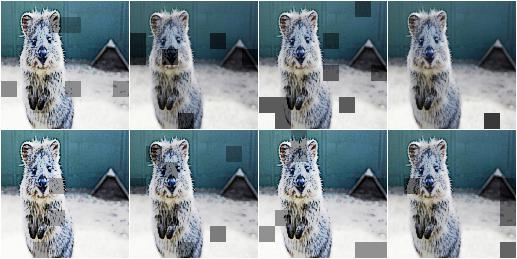
Mixing imgaug.augmenters.convolutional.Sharpen and
imgaug.augmenters.arithmetic.CoarseDropout via
imgaug.augmenters.blend.BlendAlpha. The resulting effect
is very different from executing them in sequence.
Similar to other augmenters, imgaug.augmenters.blend.BlendAlpha
supports a per_channel mode, in which it samples blending strengths
for each channel independently. As a result, some channels may show more
from the foreground (or background) branch’s outputs than other
channels. This can lead to visible color effects. The following example
is the same as the one above, only per_channel was activated.
iaa.BlendAlpha(..., per_channel=True)
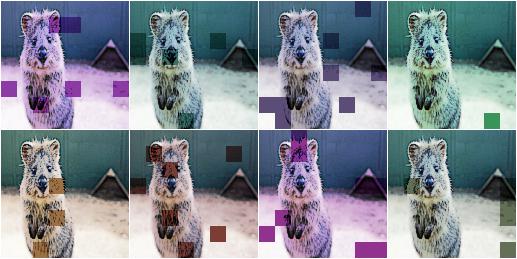
Mixing imgaug.augmenters.convolutional.Sharpen and
imgaug.augmenters.arithmetic.CoarseDropout via
imgaug.augmenters.blend.BlendAlpha and per_channel
set to True.
imgaug.augmenters.blend.BlendAlpha can also be used with
augmenters that change the position of pixels, leading to “ghost”
images. (This should not be done when also augmenting keypoints, as
their position becomes unclear.)
seq = iaa.BlendAlpha(
factor=(0.2, 0.8),
foreground=iaa.Affine(rotate=(-20, 20)),
per_channel=True
)
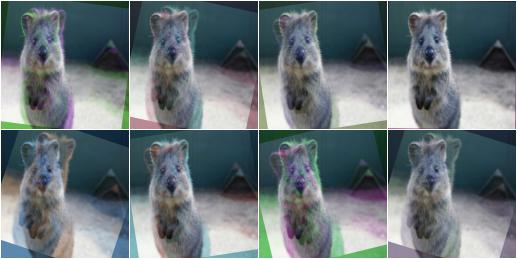
Mixing original images with their rotated version. Some channels are more visibly rotated than others.
BlendAlphaSimplexNoise¶
imgaug.augmenters.blend.BlendAlpha uses a constant blending
factor per image (or per channel). This limits its possibilities.
Often, a more localized factor is desired to create unusual
patterns. imgaug.augmenters.blend.BlendAlphaSimplexNoise is
an augmenter that does that. It generates continuous masks following
simplex noise and uses them to perform local blending. The following
example shows a combination of
imgaug.augmenters.blend.BlendAlphaSimplexNoise and
imgaug.augmenters.arithmetic.Multiply (with
per_channel=True) that creates blobs of various
colors in the image.
import imgaug as ia
from imgaug import augmenters as iaa
ia.seed(1)
# Example batch of images.
# The array has shape (8, 128, 128, 3) and dtype uint8.
images = np.array(
[ia.quokka(size=(128, 128)) for _ in range(8)],
dtype=np.uint8
)
seq = iaa.SimplexNoiseAlpha(
foreground=iaa.Multiply(iap.Choice([0.5, 1.5]), per_channel=True)
)
images_aug = seq(images=images)
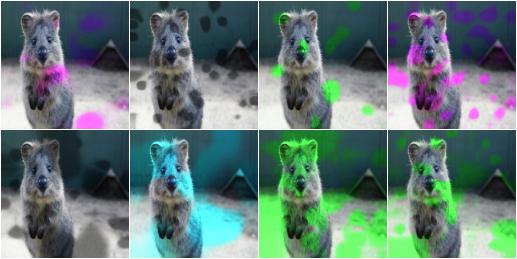
Mixing original images with their versions modified by
imgaug.augmenters.arithmetic.Multiply (with
per_channel set to True).
Simplex noise masks are used for the blending process, leading
to blobby patterns.
imgaug.augmenters.blend.BlendAlphaSimplexNoise also supports
per_channel=True, leading to unique noise masks sampled per channel.
The following example shows the combination of
imgaug.augmenters.blend.BlendAlphaSimplexNoise (with
per_channel=True) and
imgaug.augmenters.convolutional.EdgeDetect.
Even though imgaug.augmenters.convolutional.EdgeDetect usually
generates black and white images (white=edges, black=everything else), here
the combination leads to strong color effects as the channel-wise noise
masks only blend EdgeDetect’s result for some channels.
seq = iaa.BlendAlphaSimplexNoise(
foreground=iaa.EdgeDetect(1.0),
per_channel=True
)
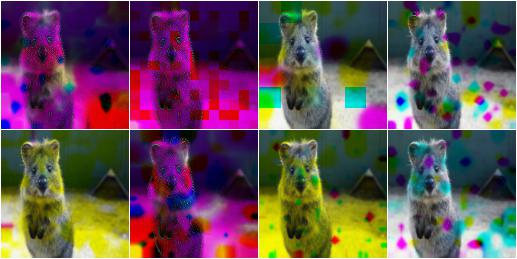
Blending images via simplex noise can lead to unexpected but diverse
patterns when per_channel is set to True. Here, a mixture of
original images with EdgeDetect(1.0) is used.
imgaug.augmenters.blend.BlendAlphaSimplexNoise uses continuous
noise masks (2d arrays with values in the range [0.0, 1.0]) to blend
images. The below image shows examples of 64x64 noise masks generated by
imgaug.augmenters.blend.BlendAlphaSimplexNoise with default settings.
Values close to 1.0 (white) indicate that pixel colors will be taken from
the first image source, while 0.0 (black) values indicate that pixel
colors will be taken from the second image source. (Often only one image
source will be given in the form of augmenters and the second will fall back
to the original images fed into
imgaug.augmenters.blend.BlendAlphaSimplexNoise.)

Examples of noise masks generated by
imgaug.augmenters.blend.BlendAlphaSimplexNoise using default
settings.
imgaug.augmenters.blend.BlendAlphaSimplexNoise generates its noise
masks in low resolution images and then upscales the masks to the size of
the input images. During upscaling it usually uses nearest neighbour
interpolation (nearest), linear interpolation (linear) or cubic
interpolation (cubic). Nearest neighbour interpolation leads to noise maps
with rectangular blobs. The below example shows noise maps generated when
only using nearest neighbour interpolation.
seq = iaa.BlendAlphaSimplexNoise(
...,
upscale_method="nearest"
)

Examples of noise masks generated by
imgaug.augmenters.blend.BlendAlphaSimplexNoise when restricting
the upscaling method to nearest.
Similarly, the following example shows noise maps generated when only using linear interpolation.
seq = iaa.BlendAlphaSimplexNoise(
...,
upscale_method="linear"
)

Examples of noise masks generated by
imgaug.augmenters.blend.BlendAlphaSimplexNoise when restricting
the upscaling method to linear.
FrequencyNoiseAlpha¶
imgaug.augmenters.blend.BlendAlphaFrequencyNoise is mostly identical
to imgaug.augmenters.blend.BlendAlphaSimplexNoise. In contrast
to imgaug.augmenters.blend.BlendAlphaSimplexNoise it uses a
different sampling process to generate the blend masks. The process is based
on starting with random frequencies, weighting them with a random exponent
and then transforming from frequency domain to spatial domain. When using a
low exponent value this leads to large, smooth blobs. Slightly higher
exponents lead to cloudy patterns. High exponent values lead to recurring,
small patterns. The below example shows the usage of
imgaug.augmenters.blend.BlendAlphaFrequencyNoise.
import imgaug as ia
from imgaug import augmenters as iaa
from imgaug import parameters as iap
ia.seed(1)
# Example batch of images.
# The array has shape (8, 64, 64, 3) and dtype uint8.
images = np.array(
[ia.quokka(size=(128, 128)) for _ in range(8)],
dtype=np.uint8
)
seq = iaa.BlendAlphaFrequencyNoise(
foreground=iaa.Multiply(iap.Choice([0.5, 1.5]), per_channel=True)
)
images_aug = seq.augment_images(images)
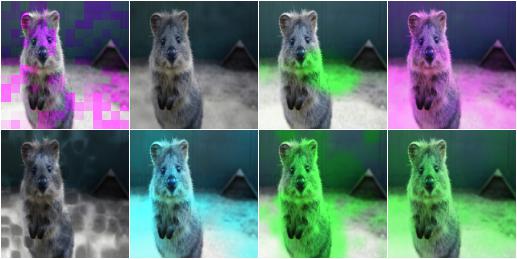
Mixing original images with their versions modified by
imgaug.augmenters.arithmetic.Multiply (with per_channel set
to True). Frequency noise masks are used for the blending process,
leading to blobby patterns.
Similarly to simplex noise,
imgaug.augmenters.blend.BlendAlphaFrequencyNoise also supports
per_channel=True, leading to different noise maps per image channel.
seq = iaa.BlendAlphaFrequencyNoise(
foreground=iaa.EdgeDetect(1.0),
per_channel=True
)
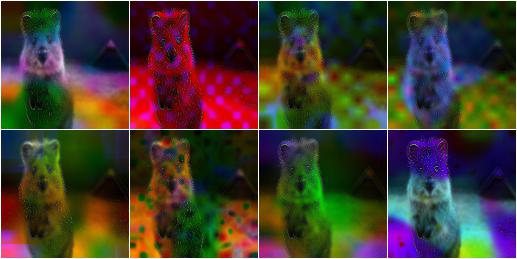
Blending images via frequency noise can lead to unexpected but diverse
patterns when per_channel is set to True. Here, a mixture of
original images with
imgaug.augmenters.convolutional.EdgeDetect(1.0) is used.
The below image shows random example noise masks generated by
imgaug.augmenters.blend.BlendAlphaFrequencyNoise with default
settings.

Examples of noise masks generated by
imgaug.augmenters.blend.FrequencyNoiseAlpha using default
settings.
The following image shows the effects of varying exponent between -4.0
and 4.0. To show these effects more clearly, a few features of
imgaug.augmenters.blend.BlendAlphaFrequencyNoise were
deactivated (e.g. multiple iterations). In the code, E is the value of
the exponent (e.g. E=-2.0).
seq = iaa.BlendAlphaFrequencyNoise(
exponent=E,
foreground=iaa.Multiply(iap.Choice([0.5, 1.5]), per_channel=True),
size_px_max=32,
upscale_method="linear",
iterations=1,
sigmoid=False
)

Examples of noise masks generated by
imgaug.augmenters.blend.BlendAlphaFrequencyNoise using default
settings with varying exponents.
Similarly to imgaug.augmenters.blend.BlendAlphaSimplexNoise,
imgaug.augmenters.blend.BlendAlphaFrequencyNoise also generates the
noise masks as low resolution versions and then upscales them to the full
image size. The following images show the usage of nearest neighbour
interpolation (upscale_method="nearest") and linear
interpolation (upscale_method="linear").

Examples of noise masks generated by
imgaug.augmenters.blend.BlendAlphaFrequencyNoise when restricting
the upscaling method to nearest.

Examples of noise masks generated by
imgaug.augmenters.blend.BlendAlphaFrequencyNoise when restricting
the upscaling method to linear.
IterativeNoiseAggregator¶
Both imgaug.augmenters.blend.BlendAlphaSimplexNoise and
imgaug.augmenters.blend.BlendAlphaFrequencyNoise wrap around
imgaug.parameters.IterativeNoiseAggregator, a component
to generate noise masks in multiple iterations. It has parameters for the
number of iterations (1 to N) and for the aggregation methods, which controls
how the noise masks from the different iterations are to be combined.
Valid aggregation methods are "min", "avg" and "max", where
min takes the minimum over all iteration’s masks, max the maxmimum
and avg the average. As a result, masks generated with method min
tend to be close to 0.0 (mostly black values), those generated with max
close to 1.0 and avg converges towards 0.5.
(0.0 means that the results of the second image dominate the final image,
so in many cases the original images before the augmenter). The following
image shows the effects of changing the number of iterations when
combining imgaug.parameters.FrequencyNoise with
imgaug.parameters.IterativeNoiseAggregator.
# This is how the iterations would be changed for BlendAlphaFrequencyNoise.
# (Same for BlendAlphaSimplexNoise.)
seq = iaa.BlendAlphaFrequencyNoise(
...,
iterations=N
)

Examples of varying the number of iterations in
imgaug.parameters.IterativeNoiseAggregator (here in
combination with imgaug.parameters.FrequencyNoise).
The following image shows the effects of changing the aggregation mode (with varying iterations).
# This is how the iterations and aggregation method would be changed for
# BlendAlphaFrequencyNoise. (Same for BlendAlphaSimplexNoise.)
seq = iaa.BlendAlphaFrequencyNoise(
...,
iterations=N,
aggregation_method=M
)
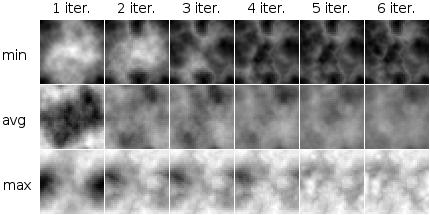
Examples of varying the aggregation method and iterations in
imgaug.parameters.IterativeNoiseAggregator (here in
combination with imgaug.parameters.FrequencyNoise).
Sigmoid¶
Generated noise masks can often end up having many values around 0.5,
especially when running
imgaug.parameters.IterativeNoiseAggregator with many iterations
and aggregation method avg. This can be undesired.
imgaug.parameters.Sigmoid is a method to compensate that. It
applies a sigmoid function to the noise masks, forcing the values to
mostly lie close to 0.0 or 1.0 and only rarely in
between. This can lead to blobs of values close to 1.0 (“use only colors from
images coming from source A”), surrounded by blobs with values close to
0.0 (“use only colors from images coming from source B”). This is similar
to taking either from one image source (per pixel) or the other, but
usually not both. Sigmoid is integrated into both
class:imgaug.augmenters.blend.BlendAlphaSimplexNoise
and imgaug.augmenters.blend.BlendAlphaFrequencyNoise. It can be
dynamically activated/deactivated and has a threshold parameter that
controls how aggressive and pushes the noise values towards 1.0.
# This is how the Sigmoid would be activated/deactivated for
# BlendAlphaFrequencyNoise (same for BlendAlphaSimplexNoise). P is the
# probability of the Sigmoid being activated (can be True/False), T is the
# threshold (sane values are usually around -10 to +10, can be a
# tuple, e.g. sigmoid_thresh=(-10, 10), to indicate a uniform range).
seq = iaa.BlendAlphaFrequencyNoise(
...,
sigmoid=P,
sigmoid_thresh=T
)
The below image shows the effects of applying
imgaug.parameters.Sigmoid to noise masks generated by
imgaug.parameters.FrequencyNoise.

Examples of noise maps without and with activated
imgaug.parameters.Sigmoid (noise maps here from
imgaug.parameters.FrequencyNoise).
The below image shows the effects of varying the sigmoid’s threshold. Lower values place the threshold further to the “left” (lower x values), leading to more x-values being above the threshold values, leading to more 1.0s in the noise masks.

Examples of varying the imgaug.parameters.Sigmoid threshold
from -10.0 to 10.0.